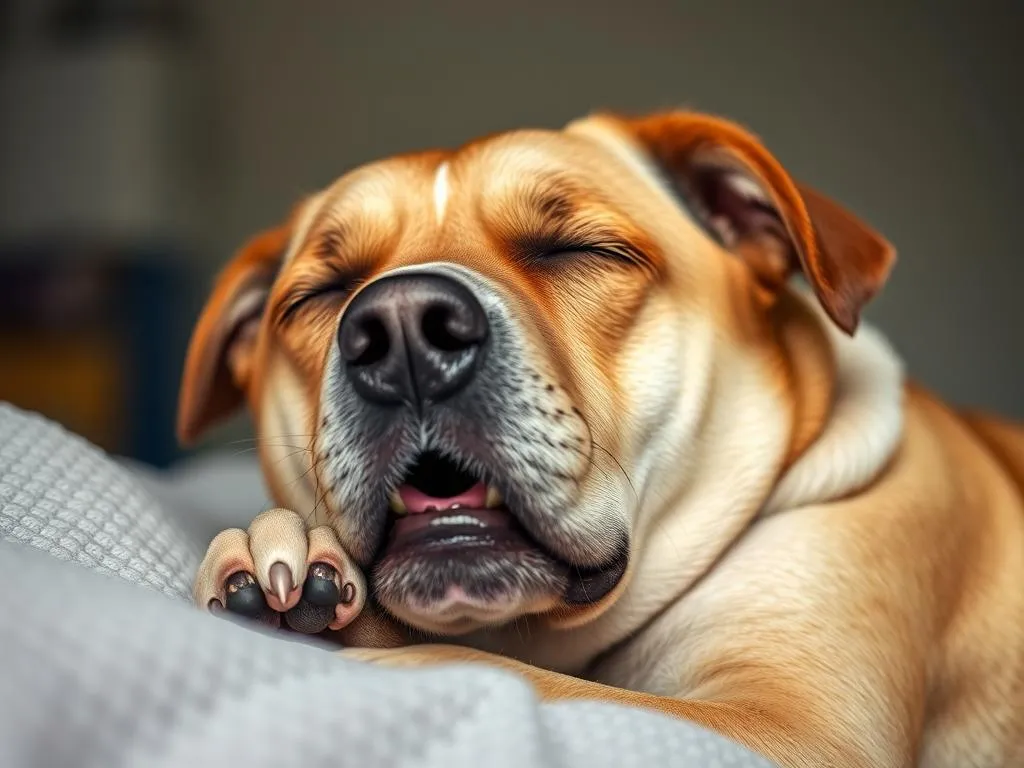
When you notice your dog breathing faster than usual while sleeping, it can be concerning. Many dog owners worry about their pets’ health and wonder what it signifies. Is it something to be alarmed about or simply a natural occurrence? Understanding canine breathing patterns is essential for every pet owner. In this article, we will explore the reasons behind fast breathing in sleeping dogs, what it may indicate about their health, and when it’s time to consult a veterinarian.
Understanding Canine Breathing
Basics of Dog Respiratory System
A dog’s respiratory system is designed to efficiently take in oxygen and expel carbon dioxide. It consists of the nasal passages, trachea, bronchi, and lungs, functioning in a manner somewhat similar to humans but with key differences. Dogs primarily breathe through their noses, which is important for their sense of smell.
Unlike humans, dogs have a more pronounced ability to pant, which helps regulate their body temperature. Additionally, a dog’s breathing is influenced by several factors, including their size, breed, and overall health. Larger breeds may naturally have slower breathing rates compared to smaller breeds, which tend to breathe more rapidly.
Normal Breathing Rates
The normal breathing rate for a resting dog typically ranges from 10 to 30 breaths per minute. When a dog is asleep, it may breathe even more slowly, often falling within the lower end of that range. However, several factors can influence these rates, including the dog’s age, activity level, and environmental conditions. For instance, puppies tend to have a higher breathing rate than older dogs.
Recognizing what is normal for your dog is crucial. A sudden deviation from their usual breathing pattern could indicate an underlying health issue.
Reasons for Fast Breathing in Sleeping Dogs
REM Sleep and Breathing Patterns
Dogs, like humans, experience different stages of sleep, including Rapid Eye Movement (REM) sleep. During REM sleep, the brain becomes more active, and this stage is often associated with dreaming. It’s during this phase that dogs may exhibit faster and more irregular breathing patterns.
If you observe your dog breathing fast while sleeping, it could simply be that they are in a deep sleep or dreaming. This is generally normal behavior and does not warrant immediate concern.
Possible Health Issues
Respiratory Conditions
Several respiratory conditions could cause a sleeping dog to breathe rapidly. Conditions such as pneumonia, bronchitis, or tracheal collapse may lead to abnormal breathing patterns. If fast breathing is accompanied by coughing, wheezing, or labored breathing, these could be signs of a more serious respiratory issue that requires veterinary attention.
Heart Problems
Fast breathing can also be an indicator of heart problems. Conditions such as congestive heart failure may cause fluid to accumulate in the lungs, resulting in rapid breathing. Dogs with heart disease may also show other symptoms, such as lethargy, coughing, or difficulty exercising. If you notice such signs along with fast breathing, it is essential to consult your veterinarian promptly.
Stress and Anxiety
Just like humans, dogs can experience stress and anxiety, which can manifest in their physical behaviors, including breathing patterns. A dog that feels anxious may breathe faster even while sleeping. Factors contributing to stress can include changes in their environment, loud noises, or separation anxiety. If you suspect that anxiety is affecting your dog, it may be helpful to explore calming techniques or consult a professional.
Environmental Factors
Sometimes, the environment plays a significant role in a dog’s breathing patterns. Factors such as high temperatures, humidity, and allergens can influence how a dog breathes. In hot weather, dogs may breathe faster as a way to cool themselves down, especially if they are not panting adequately. Ensuring your dog has a comfortable environment can help mitigate these effects.
When to Seek Veterinary Advice
Signs of Concern
While fast breathing can be a normal occurrence during sleep, there are specific signs that may indicate a more serious problem. If your dog displays any of the following symptoms alongside rapid breathing, it’s time to seek veterinary advice:
- Coughing or wheezing
- Blue-tinged gums or tongue
- Lethargy or weakness
- Difficulty waking up
- Loss of appetite
- Excessive drooling
Questions to Ask Your Vet
When you take your dog to the vet for fast breathing, consider asking the following questions to gain a better understanding of the situation:
- What could be causing my dog’s fast breathing?
- Are there any specific tests you recommend for diagnosis?
- Should I monitor my dog’s breathing at home? If so, how?
- What treatment options are available if a health issue is identified?
Diagnostic Procedures
Your veterinarian may recommend several diagnostic procedures to evaluate your dog’s condition. Common tests include:
- X-rays: To visualize the lungs and heart for any abnormalities.
- Blood tests: To check for infections, anemia, or other underlying issues.
- Ultrasound: To assess the heart’s function and structure.
- Bronchoscopy: A procedure that allows the vet to look inside the airways.
Diagnostic tests can provide valuable insights into your dog’s health and help determine the best course of action.
Tips for Monitoring Your Dog’s Breathing
Home Observation Techniques
Keeping an eye on your dog’s breathing patterns at home can help you stay informed about their health. Here are some tips for effective monitoring:
- Observe regularly: Take note of your dog’s breathing at different times of the day, especially when they are resting or sleeping.
- Use a timer: Count the number of breaths your dog takes in one minute to determine their normal rate.
- Look for changes: Be alert for any changes in breathing patterns or behaviors that seem unusual.
Keeping a Health Journal
Documenting changes in your dog’s behavior and breathing patterns can be beneficial for veterinary visits. A health journal should include:
- Dates and times of observations
- Breathing rates and patterns
- Any accompanying symptoms (e.g., coughing, lethargy)
- Changes in diet, exercise, or environment
This information can provide your veterinarian with valuable context and help in diagnosing any issues.
Conclusion
Understanding why does dog breathe fast while sleeping is crucial for pet owners to ensure their dogs remain healthy and happy. While fast breathing can be a normal part of the sleep cycle, it can also signal underlying health concerns. By being observant and proactive, you can help ensure your furry friend receives the care they need. If you notice any concerning signs or changes in your dog’s breathing, don’t hesitate to reach out to your veterinarian for guidance and support. Your dog’s health is a priority, and being informed is the first step in keeping them safe and sound.









